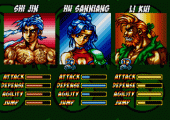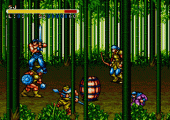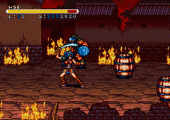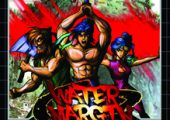Genre: Beat-‘Em-Up Developer: Never Ending Soft Publisher: Piko Interactive Players: 1-2 Released: 2015
There market for video games on discontinued consoles has continued to grow with a small but committed community of developers translating, reproducing, porting, and even making new video games for old consoles. Much of this may be driven by the widespread nostalgia for retro video games but this enthusiasm has also seen the release of games previously unavailable to many audiences. Many of these titles were previously released in Japan or Asia with no English translation. Some had such limited production that getting an original copy is beyond the price range of the average consumer. Other games were never even published and later discovered in old development kits. Water Margin – The Tales of Clouds and Winds fits into many of these categories.
Water Margin was originally released in 1996 ( and re-released in 1999) as Shui Hu Feng Yun Zhuan in Taiwan for the Sega Mega Drive. The game was not licensed by Sega and actually used assets and samples from other titles. The original cartridge is extremely rare though the ROM is widely available on the Internet. Piko Interactive secured the rights to the game, translated it into English, removed the copyrighted content (though some effects still look and sound familiar), and re-released it physically in 2015. The English title is a direct translation of the original based on the classic Chinese novel of the same name. This novel is also known as Outlaws of the Marsh, and all three of the playable characters are from the original novel.
The ancient Chinese setting for Water Margin is unique for the genre, especially on the Mega Drive. The three playable characters are Shi Jin, Hu Sanniang, and Li Kui. Shi is the all-rounder with good offensive and defensive capabilities, Hu is the female character who has good weapon reach, speed, and defence. Li Kui is fast and powerful and is a better option for advanced players. While characters have different stats, they all have the same move set with a basic combo, jump attacks, and a special attack. Similar to the Golden Axe series, there is a magic system but the spells power-ups are found within stages and none are unique to any one character.
The game mechanics while responsive and easy to pick up but dated even compared to early beat-’em-ups. Water Margin actually has fewer available moves than the original Double Dragon, Final Fight, Golden Axe and Streets of Rage. There is no grappling or throw system and no character has any unique move set. There are also no weapon pick-ups outside of the magic power-ups. Some of this can be put down to the setting but for a game that came out in 1996, it is hard not to notice the lack of variety between characters outside their stats.
It would generally be redundant to use the word “repetitive,” as this is a feature rather than a bug in the beat-‘em-up genre. Fighting the same goons who wear slightly different clothing or have slightly longer health bars over and over again is not unexpected and remains the case even in more modern beat-’em-ups. Even with this in mind, the gameplay in Water Margin is still repetitive. In round after round, there are wave after wave of enemies often clustered in seemingly thoughtless ways. Each stage will involve walking vertically before being stopped by two or more waves and then moving on. This is even more the case later in the game, and scenery is repeated often too. There are no real novelties in stages that break up the action, and even most of the boss characters are seen more than once before the final round.
Where Water Margin excels is its soundtrack and visual design. The soundtrack is simply fantastic and certainly up there with the best on the Mega Drive. Each round has a unique track and most are thumping, lively compositions that match well with the action. The sound effects aren’t very good at all, possibly because some previously “borrowed” effects had to be replaced. The clashing of weapons, enemy screams, and magic effects pale in comparison with the music. The visual design is also great and despite the usual colour swaps, there is a good variety of enemy types too. The generic names – “lancer,” “muscle man,” “tough girl,” “elite soldier,” etc. are disappointing, but I assume they are direct translations of the original names. The visuals are colourful and all the onscreen characters are well animated. The backgrounds are also detailed which makes their frequent repetition more forgivable.
Water Margin is recommended for collectors and fans of the beat-’em-up genre though the latter should not go in expecting a game that betters Sega and Capcom’s efforts. Like most games in the genre, it is a lot more fun in two-player mode, and there are difficulty levels to extend it further; the easiest of which will not see you to the end. It is also just cool to see an almost-forgotten game released in English and to see the Mega Drive library expanded even further. As of writing, it can still be ordered through Piko Interactive but is also available digitally for PC on both Steam and GOG.com.
SCORE: 7 out of 10










Recent Comments